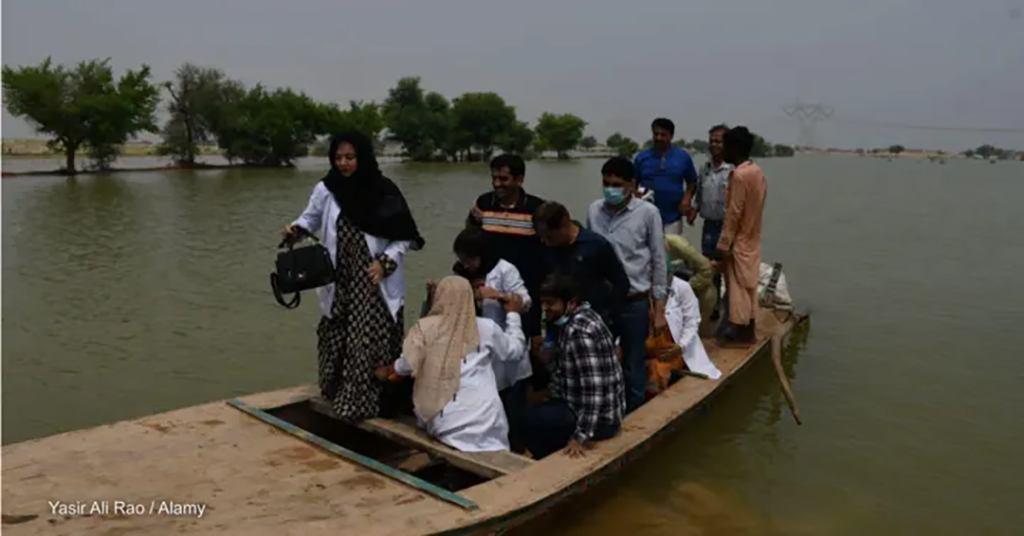As climate change creates a world in which extreme weather is the norm — so too are large-scale, deadly health outbreaks. And these crises aren’t contained to regions — extreme weather in one part of the world can be linked to health outbreaks in another.
By Sara Jerving // 14 September 2023
A significant case of this happened last year. Pakistan’s floods that submerged one-third of the nation fueled its largest cholera outbreak in decades of more than 335,000 suspected cases. Malawi also experienced flooding and Cyclone Freddy which fueled its largest cholera outbreak on record — with nearly 59,000 cases.
A group of researchers recently published a paper that presented “strong evidence” linking the two crises in both countries — the strain of the bacteria that causes cholera was new to Malawi and is the same strain that circulated during Pakistan’s floods some 3,800 miles away.
The researchers wrote that it’s possible an airplane traveler carried the bacteria from Pakistan to Malawi — the two countries are closely linked by a high frequency of air traffic.
This is not the first time that a strain has moved from a South Asian nation to an African one — and having this knowledge can actually be key to preparation, Tulio de Oliveira, director of the Centre for Epidemic Response and Innovation at Stellenbosch University in South Africa, told Devex. De Oliveria is one of the co-authors of the paper.
He added that when there is a large outbreak in South Asia with a new strain of cholera, African public health officials should ramp up surveillance to identify if this new strain lands within their borders. That might then give them a few months lead time in order to prepare for a larger outbreak.
And with the climate changing, it becomes a more pressing need.
“Unfortunately, the number and the size of floods are becoming more extreme in the recent past, especially the last couple of years,” de Oliveira said.
A strain on the move
It’s believed the strain of the bacteria that circulated during the major floods in Pakistan last year between June to October was introduced in Malawi around July 2022 — during the nation’s dry season, de Oliveira said.
When looking at air travel into Malawi in the first half of last year, Pakistan had the second-highest number of international arrivals from South Asia and seventh-highest globally.
In the months after the introduction of the new strain, there were only a small number of cholera cases in Malawi due to the dry season. But then the rainy season came in late November, accompanied by flooding, which led to a massive amplification of the number of cases. It was then escalated further by Cyclone Freddy, which hit earlier this year.

“It completely shocked both the population and the health care staff in Malawi,” de Oliveira said.
With the floods and cyclone, water sources were contaminated and there was large-scale displacement of communities. This movement of people also allowed the bacteria to reach populations that lived in areas relatively unaffected by cholera for over a decade.
Last December, the government declared a public health emergency, with cases present in all of the country’s 29 districts.
The outbreak was part of an uptick of climate-fueled cholera outbreaks globally.
Deadly new strains
The last major cholera outbreak in Malawi occurred in 2002 and a less severe one took place between 2008 and 2009.
“We are talking about 20 years without a very large outbreak,” de Oliveira said.
For cholera, there are two main triggers of epidemics, de Oliveira explained. There are natural circulating lineages of the bacterium that live in the environment but these are not known for causing large outbreaks. There is still uncertainty as to why, de Oliveira said, but it seems these strains adapt to the environment, are less transmissible, and potentially the population has immunity to that local strain.
But new strains can spread fast and cause more damage.
“The population will have low immunity to a new strain and that can cause a very large outbreak,” de Oliveira said.
And it’s not uncommon cholera strains originating in South Asian nations such as Pakistan, Bangladesh, Nepal and India are introduced into African nations — this has happened for decades, de Oliveira said.
He added that researchers established this by conducting genomic analysis of thousands of cholera samples — which identified that all of the previous 13 strains of cholera that have contributed to the past 13 large outbreaks of cholera over the past 55 years in African nations come from strains related to vibrio cholerae O1 isolates from South Asia, and not strains endemic to African nations.
In the Malawi outbreak, researchers from the Public Health Institute of Malawi and the Centre for Epidemic Response and Innovation linked the strain to the one circulating in Pakistan through genomic sequencing. Genomic surveillance also indicated that the strain was new to Pakistan.
This new strain proved to be more deadly. The Malawi outbreak had a high case fatality ratio of 3%, which was over 1,760 deaths.
“The case fatality ratio is extremely high for 2022,” de Oliveira said. “The case fatality ratio in most of the world has been below 1%.”
Reasons for this can include higher transmissibility and lower immunity of the population to a new strain, and also that it wasn’t the only crisis the country was managing. During a climate emergency, such as flooding, there are damaged hospitals and other medical needs, such as ensuring there are surgical wards for women delivering babies.
“It’s a situation where the simple becomes difficult because now you have to deal with a lot of things,” de Oliveira said. “They were completely unprepared. With floods, you have large populations moving. They didn’t have the hydration tents — they weren’t equipped to hydrate the people.”
It’s similar to what happened during the COVID-19 pandemic, de Oliveira said. “The sheer magnitude of the number of patients that need medical attention at a given time — the health facilities get overwhelmed and then you have a higher case fatality ratio.”
Last month, the Malawian government declared the cholera outbreak is no longer a national public health emergency.>Preparing for the storm
In Malawi, the new strain wasn’t detected soon after it was introduced into the country during the dry season. Without using genomic surveillance, cases can be confused with a more endemic circulation of cholera.
“With genomics, you will be able to see that it’s a completely different new strain that has recently caused a large outbreak in another part of the world,” de Oliveira said. He added that because of this, countries should use this type of surveillance more frequently when cholera cases are detected in a country.
And if there is a large cholera outbreak in South Asia, public health officials can expect a new strain might arrive in African nations.
“We know that cholera especially travels very well in people by airplanes. A lot of people will not suspect that they have cholera and think they just have a stomach bug. That would not stop them from traveling,” de Oliveira said.
A new strain identified in a country should then send off alarm bells — given the damage new strains can cause.
A lot of times these strains are introduced during what are the rainy seasons in South Asia, when cholera is circulating, which is simultaneously the dry seasons in parts of Africa — and then are amplified when African nations enter into their rainy seasons.
In the case of last year’s outbreak in Malawi, that meant there were about five months of low cases following the introduction of the new strain before the rainy season hit. De Oliveira said the public health community can use months of low transmission after the introduction of a new strain to prepare for large outbreaks.
Preparations in the leadup to a cholera outbreak can include ensuring a country has adequate stocks of supplies for hydration — hydration tents, salts, and intravenous fluids. Cholera is easily treatable but can kill someone in hours without treatment. Countries can also launch cholera vaccination campaigns.
It’s often difficult to arrange for large shipments of these commodities quickly in an emergency, de Oliveira said. And delays can result in lives lost.
Manuscript: Genomic epidemiology of the cholera outbreak in Malawi 2022-2023
News date: 2023-09-14
Links:
Publication cited

Genomic epidemiology of the cholera outbreak in Malawi 2022-2023. Chabuka L, Choga WT, Mavian CN, Moir M, Tegally H, Wilkinson E, Naidoo Y, Inward R, Morgenstern C, Bhatt S, Wint WGR, Khan K, Bogoch II, Kraemer MUG, Baxter C, Tagliamonte M, Salemi M, Lessells RJ, Mitambo C, Chitatanga R, Bango JB, Chiwaula M, Chavula Y, Bukhu M, Manda H, Chitenje M, Malolo I, Mwanyongo A, Mvula B, Nyenje M, de Oliveira T, Kagoli M, medRxiv(2023), https://doi.org/10.1101/2023.08.22.23294324:.

